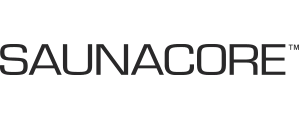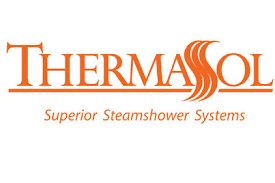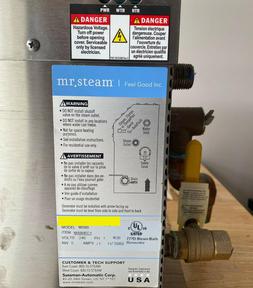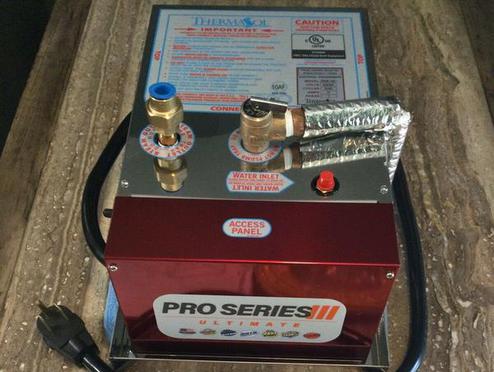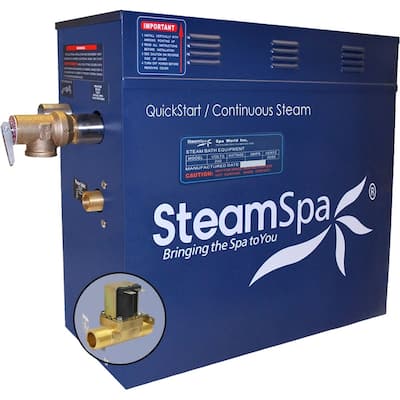Choosing Between the 3 Generator Types
Type 1 - Single tank steam geneators (range from 10 psi to 20psi)
Type 2 - Dual pressurized tanks - one small and one big tank
Type 3 - Atmospheric steam generators - atmospheric pressure, non pressurized steam
Type 1 - Single tank steam generators (Mr. Steam, Amerec, Steamist, Elite Steam)
These can range from really cheap that spit out water that you can always see coming out of the steam head and make steam that drips the entire time or the high end single tank generators have high psi (20 psi) that gives off steam almost as dry as an atmospheric type steam generator. The only downside its that the single tanks have the longest duty cycles when its not making steam.
If you are going to get a single tank generator (like a Mr. Steam or something similar), these are the ones that have higher pressure relief valves and better welding and don't break down like the Chinese import models you see advertised everywhere. Single tank generators that release larger loads of steam at once can work much better if using 3/4 inch pipes. Those who use 1/2 inch pipes can have a loud sounding steam and heavier condensate as a 3/4 inch pipe helps that problem.
If you are going to get a single tank model, Mr. Steam is the most popular brand and Steamist 2nd from customers I help. I have the least problems with the higher psi brands that are CSA certified and not just UL and CE certified. Higher psi makes hotter steam as more pressure is created. Higher psi also create a lower micron size steam and doesn't spit out the water out of the steam head like the cheaper models.
Lower psi single tank generators are the type that often spit out water from the steam head and give off a heavy steam that feels nothing like the 20 psi models. The downside of getting a high end 20 psi model is that they scale up more. Under high pressures, limescale develops over time and even with an auto flush you might have to change out heating elements every few years. Also, you might have to change out the boiling tank every few years also if you don't want that mineral smell in your steam room. Also when the limescale is coating the heating elements, they don't get as hot and it is possible that if there is too much mineral deposits on the elements, it will overheat and cause it to burn out.
Note: if you have a small steam room, you may not want the 20 psi models as they shoot out steam with more force and can burn your feet and legs as it comes out. Please contact me about this.
visual of a low psi model
You can see steam spitting out
visual of a high psi model
Steam is dry and comes out almost invisible
Atmospheric steam generators
These came out after the dual tanks and is the latest in steam generators.
The atmospheric generators are a slow burn type generator that releases the same amount of steam as a pressurized generator but over a longer period of time. If a pressurized puts out 100 grams of steam in 25 seconds, this would put it out over a much longer time. It is a continuous burn rather than dumping the entire load out at once when pressure relief valve opens.
For ceilings at 7 foot tall, it doesn't matter as much since the thermocline of steam will naturally be at the body core level. If someone has tall ceilings then atmospheric steam helps prevent the steam from being trapped at the ceiling and the latent heat is given off over a longer period of time so the walls don't heat up as much and condense the steam cloud. (Note: if you splash cold water on the walls and ceiling you will notice immediately the steam cloud comes back).
Atmospheric generators are super quiet as they don't have lots of pressure behind it. Also, the steam produced is the closest to a sweat lodge. Dry steam doesn't mean the steam room is dry and has less steam. The best way I know to describe it is pouring water on a hot skillet and watching the steam rise to the ceiling. Another demonstration we did is we froze a block of ice and put it on a sauna heater. The gallon of ice melted very slowly and gave off a constant steam the entire session. This is different than the steam bubbling off a pot of boiling water. That is wet steam.
Atmospheric steam generators are very expensive. They cost around $500 to $600 per killowatt. The cheapest Chinese import generators cost around $80 to $100 per killowatt. The dual tanks can cost on average $175 to $200 per killowatt. There is a huge jump in price when you go up to atmospheric. There is never water hammer with the atmospheric type and you don't need a water filter if you have hard water
Also, for those using fans in their steam room, atmospheric steam is much easier to control to stay in the 110 to 114 degree sweet spot range. When steam comes out in a burst then stops for a few minutes, the fans aren't as effective as it would be when constantly circulating a slow burn continuous steam. For those wanting full body steam therapy, using a floor fan facing upward will help displace the cold air at the floor and mix it with the super hot ceiling steam at the ceiling. For those wanting a 20 to 30 minute session and don't want to wait for steam during duty cycles or don't want to stay in for 45 minutes to an hour, having a steam that is easier to tweak will make it easier for whole body steam therapy (feet and legs at same temperature as upper body). Just 12 inches can change the thermocline from the sweet spot window to 10 degrees lower if the steam is too wet and heavy.
This video below helps show a visual of a comparison between pressurized steam vs atmospheric.
DiscountSteamGenerators.com
We're open now
1-800-336-9285
Ask for Sharon
We're open now
1-800-336-9285
Ask for Alex
Know before buying a steam generator
Know before buying a steam generator
Know before buying a steam generator
DiscountSteamGenerators.com
We're open now
1-800-336-9285
Ask for Sharon
We're open now
1-800-336-9285
Ask for Alex
Type 2 - Dual pressurized tanks - Large tank and a smaller tank
Steamspa and Thermasol are the 2 main brands that make dual tank steam generators. This came out after the single tanks that were first made for steam rooms. People in the past would hose down the walls to get rid of the latent heat stored in the tiles or would put cold water on the temperature sensor.
The dual tank now made steam rooms continuous and the big tank releases the main steam and the smaller tank comes on when the big tank is heating back up. The tanks go back and forth to make a constant steam. The dual tanks come in either 15 or 20 psi depending on the model. The 20 psi models give the driest steam and use less water. The lower the psi the more water (condensate) that is released and this is what I try to avoid.
When deciding between the dual tanks, some people prefer more smart home where they can program it to come on in the morning right when they wake up and some people like using apps or what a high lumen LED light system. Also, as far as speakers, one brand sounds way better than the other. The other brand has 20psi tanks and uses 3/4 inch pipes and is quieter. Notice: if you get the model that has the better steam quality, it is not as efficient and you might have to change heating elements every 2 to 3 years instead of every 5 years. But, if you want the high dryness fraction steam quality, most people don't mind changing out elements and boiling tanks every few years.
If you want a constant steam and want a fast burn steam I can help you compare the Steamspa to the Thermasol. There are pros and cons of each. The most important choice is if you are really into the "smart home" features.


